Ethical Leadership: Characteristics, Impact, 4-V Model, and Examples
VerifiedAdded on 2023/06/13
|15
|3891
|145
Essay
AI Summary
This essay provides a comprehensive overview of ethical leadership, beginning with an introduction to its increasing importance in the 21st century and defining it as a leadership style that enables individuals to act for the common good. It details the key characteristics of ethical leaders, including justice, respect, honesty, humane attitude, focus on team building, value-driven decision making, encouraging initiatives, leading by example, valuing awareness, and zero tolerance for ethical violations. The essay further explores the impact of ethical leadership on individual well-being, team energy, and organizational health, emphasizing the creation of a positive and productive work environment. It also explains the 4-V Model of Ethical Leadership, highlighting the importance of values, vision, voice, and virtue in aligning internal beliefs with external actions for the common good. Finally, the essay discusses the impact of ethical leadership on employee turnover and job performance, noting its importance in promoting ethical conduct and open communication within organizations, supported by organizational examples.

Running head: ETHICAL LEADERSHIP
Ethical Leadership
Name of Student:
Name of University:
Author’s Note:
Ethical Leadership
Name of Student:
Name of University:
Author’s Note:
Paraphrase This Document
Need a fresh take? Get an instant paraphrase of this document with our AI Paraphraser
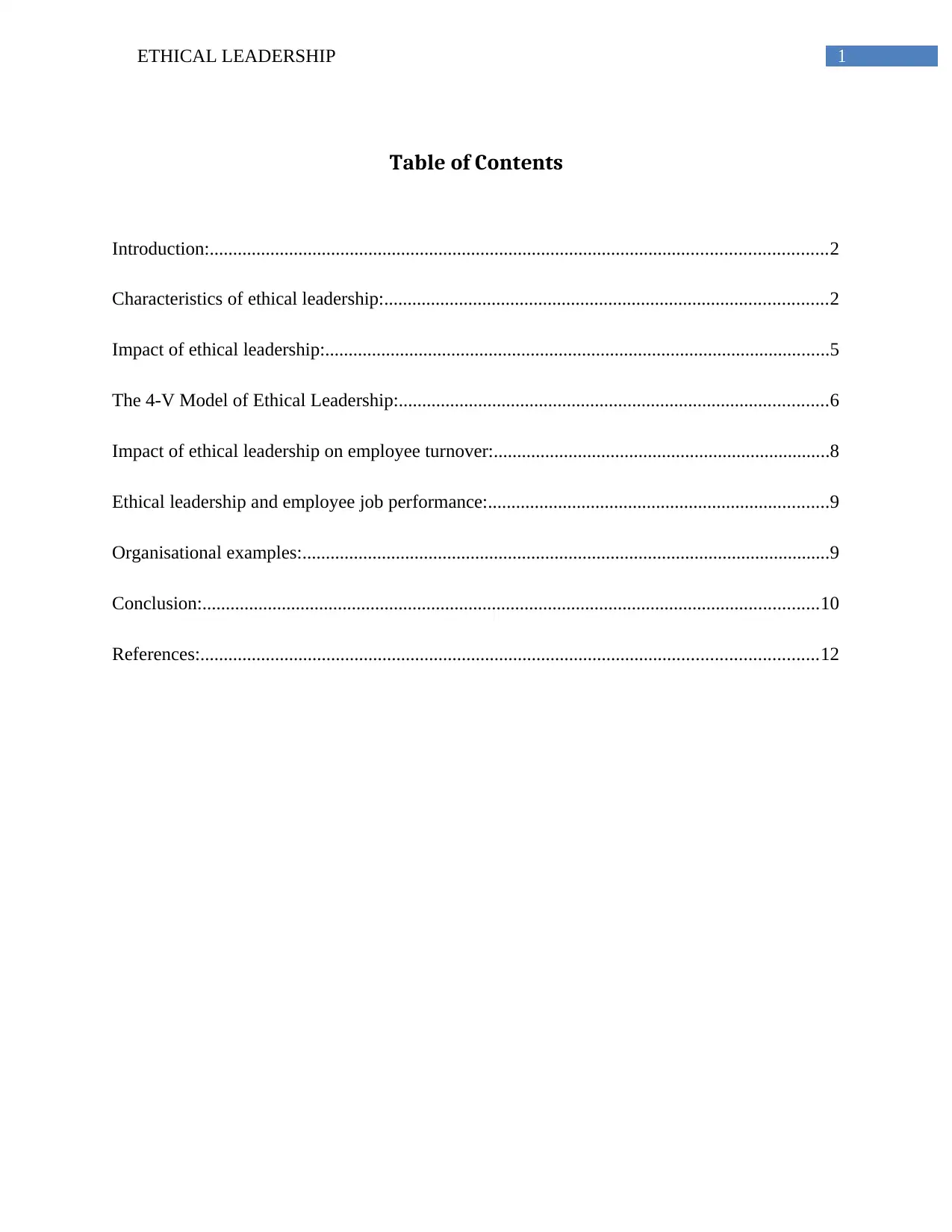
1ETHICAL LEADERSHIP
Table of Contents
Introduction:....................................................................................................................................2
Characteristics of ethical leadership:...............................................................................................2
Impact of ethical leadership:............................................................................................................5
The 4-V Model of Ethical Leadership:............................................................................................6
Impact of ethical leadership on employee turnover:........................................................................8
Ethical leadership and employee job performance:.........................................................................9
Organisational examples:.................................................................................................................9
Conclusion:....................................................................................................................................10
References:....................................................................................................................................12
Table of Contents
Introduction:....................................................................................................................................2
Characteristics of ethical leadership:...............................................................................................2
Impact of ethical leadership:............................................................................................................5
The 4-V Model of Ethical Leadership:............................................................................................6
Impact of ethical leadership on employee turnover:........................................................................8
Ethical leadership and employee job performance:.........................................................................9
Organisational examples:.................................................................................................................9
Conclusion:....................................................................................................................................10
References:....................................................................................................................................12
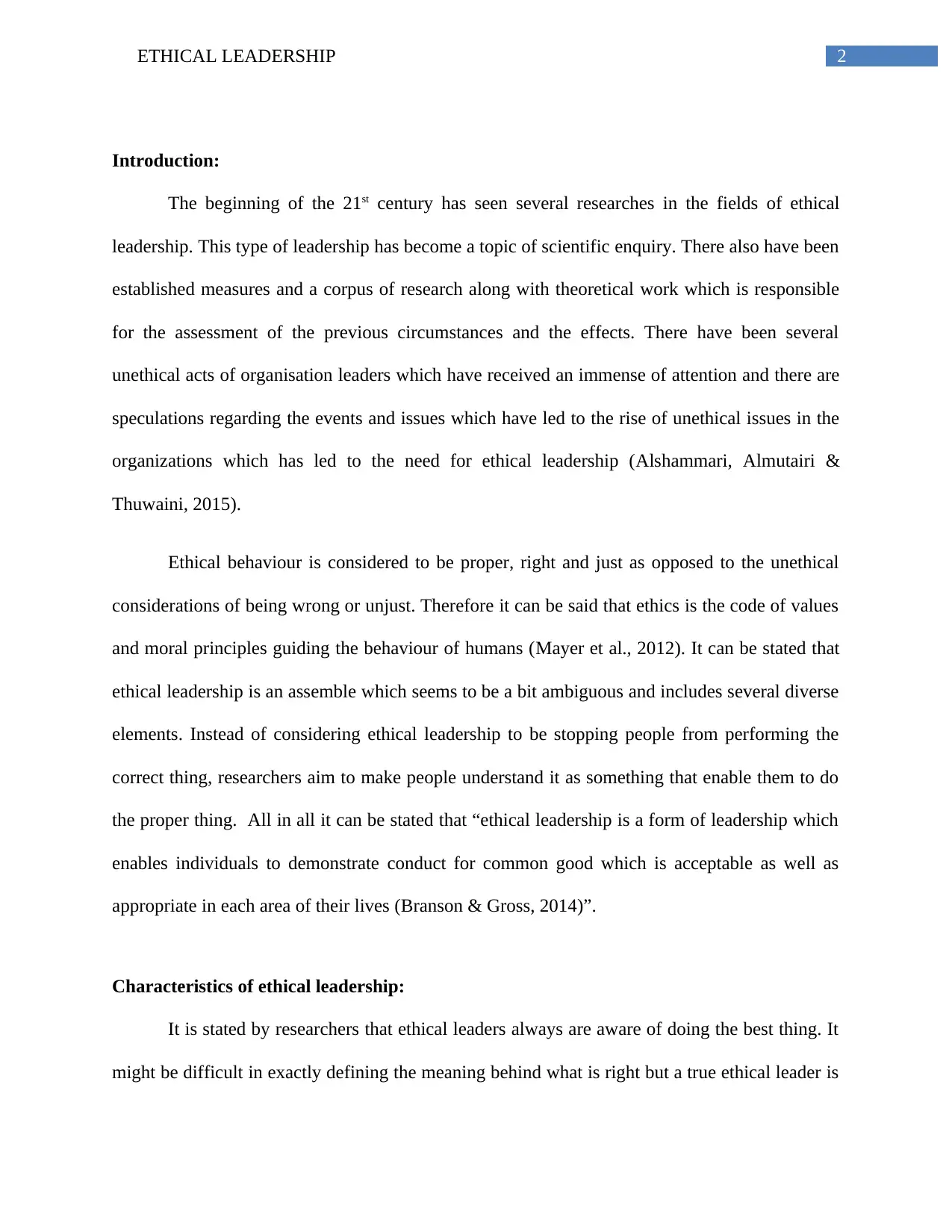
2ETHICAL LEADERSHIP
Introduction:
The beginning of the 21st century has seen several researches in the fields of ethical
leadership. This type of leadership has become a topic of scientific enquiry. There also have been
established measures and a corpus of research along with theoretical work which is responsible
for the assessment of the previous circumstances and the effects. There have been several
unethical acts of organisation leaders which have received an immense of attention and there are
speculations regarding the events and issues which have led to the rise of unethical issues in the
organizations which has led to the need for ethical leadership (Alshammari, Almutairi &
Thuwaini, 2015).
Ethical behaviour is considered to be proper, right and just as opposed to the unethical
considerations of being wrong or unjust. Therefore it can be said that ethics is the code of values
and moral principles guiding the behaviour of humans (Mayer et al., 2012). It can be stated that
ethical leadership is an assemble which seems to be a bit ambiguous and includes several diverse
elements. Instead of considering ethical leadership to be stopping people from performing the
correct thing, researchers aim to make people understand it as something that enable them to do
the proper thing. All in all it can be stated that “ethical leadership is a form of leadership which
enables individuals to demonstrate conduct for common good which is acceptable as well as
appropriate in each area of their lives (Branson & Gross, 2014)”.
Characteristics of ethical leadership:
It is stated by researchers that ethical leaders always are aware of doing the best thing. It
might be difficult in exactly defining the meaning behind what is right but a true ethical leader is
Introduction:
The beginning of the 21st century has seen several researches in the fields of ethical
leadership. This type of leadership has become a topic of scientific enquiry. There also have been
established measures and a corpus of research along with theoretical work which is responsible
for the assessment of the previous circumstances and the effects. There have been several
unethical acts of organisation leaders which have received an immense of attention and there are
speculations regarding the events and issues which have led to the rise of unethical issues in the
organizations which has led to the need for ethical leadership (Alshammari, Almutairi &
Thuwaini, 2015).
Ethical behaviour is considered to be proper, right and just as opposed to the unethical
considerations of being wrong or unjust. Therefore it can be said that ethics is the code of values
and moral principles guiding the behaviour of humans (Mayer et al., 2012). It can be stated that
ethical leadership is an assemble which seems to be a bit ambiguous and includes several diverse
elements. Instead of considering ethical leadership to be stopping people from performing the
correct thing, researchers aim to make people understand it as something that enable them to do
the proper thing. All in all it can be stated that “ethical leadership is a form of leadership which
enables individuals to demonstrate conduct for common good which is acceptable as well as
appropriate in each area of their lives (Branson & Gross, 2014)”.
Characteristics of ethical leadership:
It is stated by researchers that ethical leaders always are aware of doing the best thing. It
might be difficult in exactly defining the meaning behind what is right but a true ethical leader is
⊘ This is a preview!⊘
Do you want full access?
Subscribe today to unlock all pages.

Trusted by 1+ million students worldwide

3ETHICAL LEADERSHIP
not afraid of doing anything which they truly consider to be right (Yukl et al., 2013). This is true
even in case it is unpopular, unprofitable or even inconvenient. The different characteristics of
“ethical leadership” are discussed as follows:
1. Justice: An “ethical” leader is found to be just and fair at all times. These leaders do not
have any favourites and are responsible for treating every person equally. Under the
guidance of ethical leaders “no employee has any reason to fear biased treatment on the
basis” of any sort of demarcations or alterations, be it gender, nationality, ethnicity or any
other factor.
2. Respect towards others: One of the main noteworthy traits of “ethical leadership” is the
respect which is provided to the followers. A leader who is ethical shows huge
admiration for all team members and also listens to them in an attentive manner and their
contribution are also valued. They are compassionate and generous at the time of
considerations of opposing viewpoints (Hassan, Wright & Yukl, 2014).
3. Honesty: In this connection it can be said that any person who is “ethical will also be
honest as well as loyal”. This is because of the reason that for effective ethical leaders,
there is a huge amount of importance on the idea of trust and dependability. Ethical
leaders are responsible for conveying fats in a transparent manner irrespective of their
negative popularity.
4. Humane: the humane attitude and nature of the ethical leaders are very popular. The
leader also needs to be ethical as well as moral. Ethical leaders are those who place huge
importance on kindness and act in ways which are always beneficial to them.
5. “Focus on teambuilding”: “Ethical” leaders help in the fostering a sense of community
and team spirit within a particular organisation. At a time when an ethical leader strives
not afraid of doing anything which they truly consider to be right (Yukl et al., 2013). This is true
even in case it is unpopular, unprofitable or even inconvenient. The different characteristics of
“ethical leadership” are discussed as follows:
1. Justice: An “ethical” leader is found to be just and fair at all times. These leaders do not
have any favourites and are responsible for treating every person equally. Under the
guidance of ethical leaders “no employee has any reason to fear biased treatment on the
basis” of any sort of demarcations or alterations, be it gender, nationality, ethnicity or any
other factor.
2. Respect towards others: One of the main noteworthy traits of “ethical leadership” is the
respect which is provided to the followers. A leader who is ethical shows huge
admiration for all team members and also listens to them in an attentive manner and their
contribution are also valued. They are compassionate and generous at the time of
considerations of opposing viewpoints (Hassan, Wright & Yukl, 2014).
3. Honesty: In this connection it can be said that any person who is “ethical will also be
honest as well as loyal”. This is because of the reason that for effective ethical leaders,
there is a huge amount of importance on the idea of trust and dependability. Ethical
leaders are responsible for conveying fats in a transparent manner irrespective of their
negative popularity.
4. Humane: the humane attitude and nature of the ethical leaders are very popular. The
leader also needs to be ethical as well as moral. Ethical leaders are those who place huge
importance on kindness and act in ways which are always beneficial to them.
5. “Focus on teambuilding”: “Ethical” leaders help in the fostering a sense of community
and team spirit within a particular organisation. At a time when an ethical leader strives
Paraphrase This Document
Need a fresh take? Get an instant paraphrase of this document with our AI Paraphraser
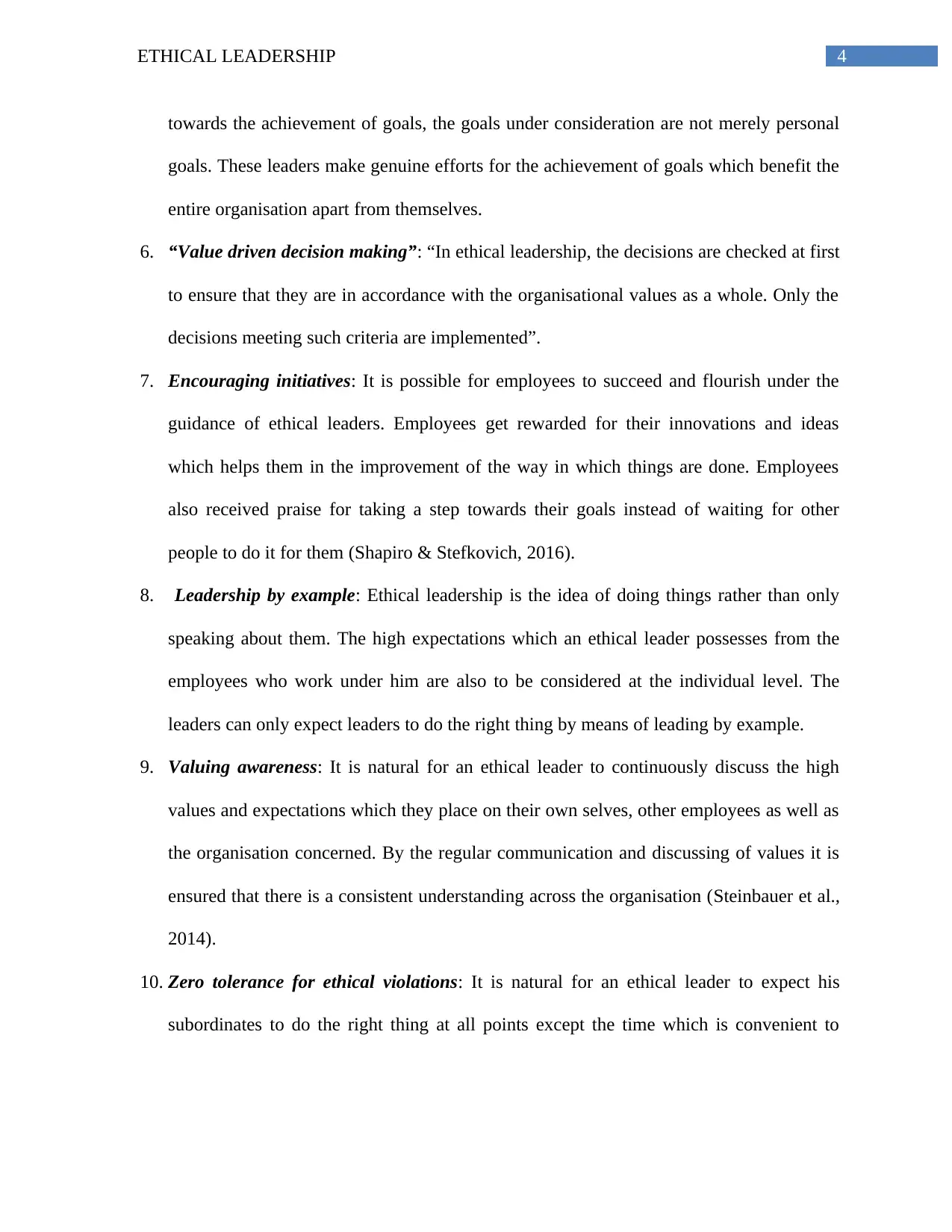
4ETHICAL LEADERSHIP
towards the achievement of goals, the goals under consideration are not merely personal
goals. These leaders make genuine efforts for the achievement of goals which benefit the
entire organisation apart from themselves.
6. “Value driven decision making”: “In ethical leadership, the decisions are checked at first
to ensure that they are in accordance with the organisational values as a whole. Only the
decisions meeting such criteria are implemented”.
7. Encouraging initiatives: It is possible for employees to succeed and flourish under the
guidance of ethical leaders. Employees get rewarded for their innovations and ideas
which helps them in the improvement of the way in which things are done. Employees
also received praise for taking a step towards their goals instead of waiting for other
people to do it for them (Shapiro & Stefkovich, 2016).
8. Leadership by example: Ethical leadership is the idea of doing things rather than only
speaking about them. The high expectations which an ethical leader possesses from the
employees who work under him are also to be considered at the individual level. The
leaders can only expect leaders to do the right thing by means of leading by example.
9. Valuing awareness: It is natural for an ethical leader to continuously discuss the high
values and expectations which they place on their own selves, other employees as well as
the organisation concerned. By the regular communication and discussing of values it is
ensured that there is a consistent understanding across the organisation (Steinbauer et al.,
2014).
10. Zero tolerance for ethical violations: It is natural for an ethical leader to expect his
subordinates to do the right thing at all points except the time which is convenient to
towards the achievement of goals, the goals under consideration are not merely personal
goals. These leaders make genuine efforts for the achievement of goals which benefit the
entire organisation apart from themselves.
6. “Value driven decision making”: “In ethical leadership, the decisions are checked at first
to ensure that they are in accordance with the organisational values as a whole. Only the
decisions meeting such criteria are implemented”.
7. Encouraging initiatives: It is possible for employees to succeed and flourish under the
guidance of ethical leaders. Employees get rewarded for their innovations and ideas
which helps them in the improvement of the way in which things are done. Employees
also received praise for taking a step towards their goals instead of waiting for other
people to do it for them (Shapiro & Stefkovich, 2016).
8. Leadership by example: Ethical leadership is the idea of doing things rather than only
speaking about them. The high expectations which an ethical leader possesses from the
employees who work under him are also to be considered at the individual level. The
leaders can only expect leaders to do the right thing by means of leading by example.
9. Valuing awareness: It is natural for an ethical leader to continuously discuss the high
values and expectations which they place on their own selves, other employees as well as
the organisation concerned. By the regular communication and discussing of values it is
ensured that there is a consistent understanding across the organisation (Steinbauer et al.,
2014).
10. Zero tolerance for ethical violations: It is natural for an ethical leader to expect his
subordinates to do the right thing at all points except the time which is convenient to
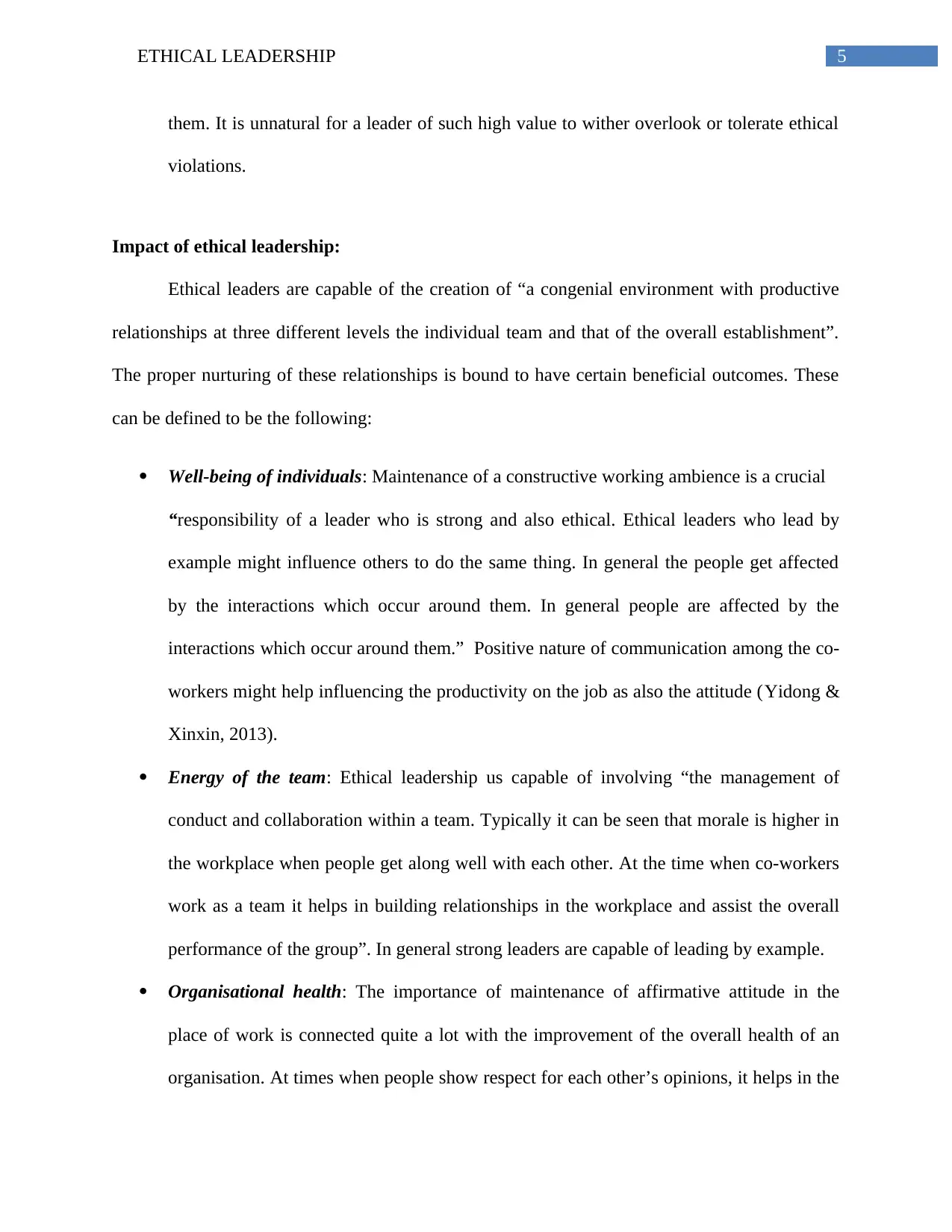
5ETHICAL LEADERSHIP
them. It is unnatural for a leader of such high value to wither overlook or tolerate ethical
violations.
Impact of ethical leadership:
Ethical leaders are capable of the creation of “a congenial environment with productive
relationships at three different levels the individual team and that of the overall establishment”.
The proper nurturing of these relationships is bound to have certain beneficial outcomes. These
can be defined to be the following:
Well-being of individuals: Maintenance of a constructive working ambience is a crucial
“responsibility of a leader who is strong and also ethical. Ethical leaders who lead by
example might influence others to do the same thing. In general the people get affected
by the interactions which occur around them. In general people are affected by the
interactions which occur around them.” Positive nature of communication among the co-
workers might help influencing the productivity on the job as also the attitude (Yidong &
Xinxin, 2013).
Energy of the team: Ethical leadership us capable of involving “the management of
conduct and collaboration within a team. Typically it can be seen that morale is higher in
the workplace when people get along well with each other. At the time when co-workers
work as a team it helps in building relationships in the workplace and assist the overall
performance of the group”. In general strong leaders are capable of leading by example.
Organisational health: The importance of maintenance of affirmative attitude in the
place of work is connected quite a lot with the improvement of the overall health of an
organisation. At times when people show respect for each other’s opinions, it helps in the
them. It is unnatural for a leader of such high value to wither overlook or tolerate ethical
violations.
Impact of ethical leadership:
Ethical leaders are capable of the creation of “a congenial environment with productive
relationships at three different levels the individual team and that of the overall establishment”.
The proper nurturing of these relationships is bound to have certain beneficial outcomes. These
can be defined to be the following:
Well-being of individuals: Maintenance of a constructive working ambience is a crucial
“responsibility of a leader who is strong and also ethical. Ethical leaders who lead by
example might influence others to do the same thing. In general the people get affected
by the interactions which occur around them. In general people are affected by the
interactions which occur around them.” Positive nature of communication among the co-
workers might help influencing the productivity on the job as also the attitude (Yidong &
Xinxin, 2013).
Energy of the team: Ethical leadership us capable of involving “the management of
conduct and collaboration within a team. Typically it can be seen that morale is higher in
the workplace when people get along well with each other. At the time when co-workers
work as a team it helps in building relationships in the workplace and assist the overall
performance of the group”. In general strong leaders are capable of leading by example.
Organisational health: The importance of maintenance of affirmative attitude in the
place of work is connected quite a lot with the improvement of the overall health of an
organisation. At times when people show respect for each other’s opinions, it helps in the
⊘ This is a preview!⊘
Do you want full access?
Subscribe today to unlock all pages.

Trusted by 1+ million students worldwide
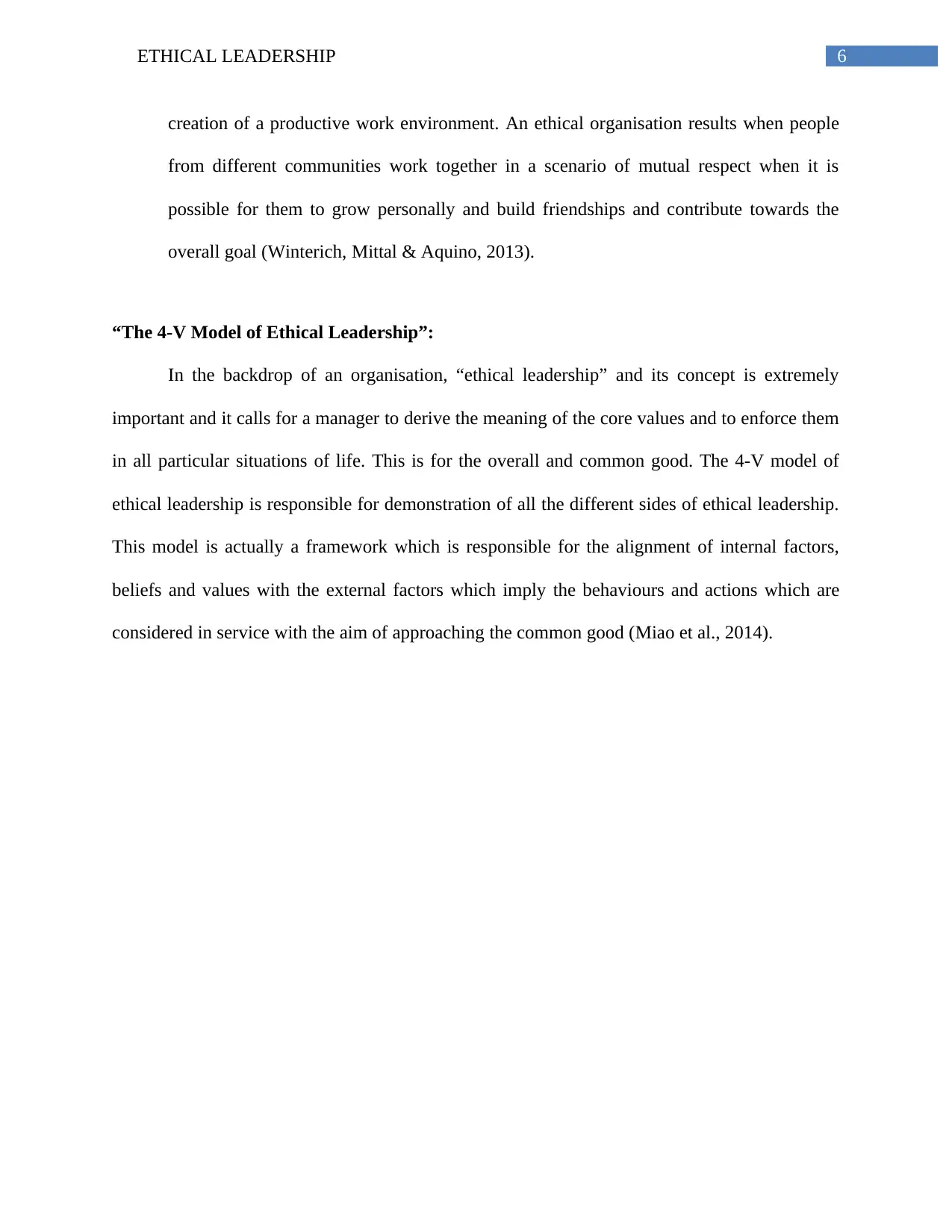
6ETHICAL LEADERSHIP
creation of a productive work environment. An ethical organisation results when people
from different communities work together in a scenario of mutual respect when it is
possible for them to grow personally and build friendships and contribute towards the
overall goal (Winterich, Mittal & Aquino, 2013).
“The 4-V Model of Ethical Leadership”:
In the backdrop of an organisation, “ethical leadership” and its concept is extremely
important and it calls for a manager to derive the meaning of the core values and to enforce them
in all particular situations of life. This is for the overall and common good. The 4-V model of
ethical leadership is responsible for demonstration of all the different sides of ethical leadership.
This model is actually a framework which is responsible for the alignment of internal factors,
beliefs and values with the external factors which imply the behaviours and actions which are
considered in service with the aim of approaching the common good (Miao et al., 2014).
creation of a productive work environment. An ethical organisation results when people
from different communities work together in a scenario of mutual respect when it is
possible for them to grow personally and build friendships and contribute towards the
overall goal (Winterich, Mittal & Aquino, 2013).
“The 4-V Model of Ethical Leadership”:
In the backdrop of an organisation, “ethical leadership” and its concept is extremely
important and it calls for a manager to derive the meaning of the core values and to enforce them
in all particular situations of life. This is for the overall and common good. The 4-V model of
ethical leadership is responsible for demonstration of all the different sides of ethical leadership.
This model is actually a framework which is responsible for the alignment of internal factors,
beliefs and values with the external factors which imply the behaviours and actions which are
considered in service with the aim of approaching the common good (Miao et al., 2014).
Paraphrase This Document
Need a fresh take? Get an instant paraphrase of this document with our AI Paraphraser
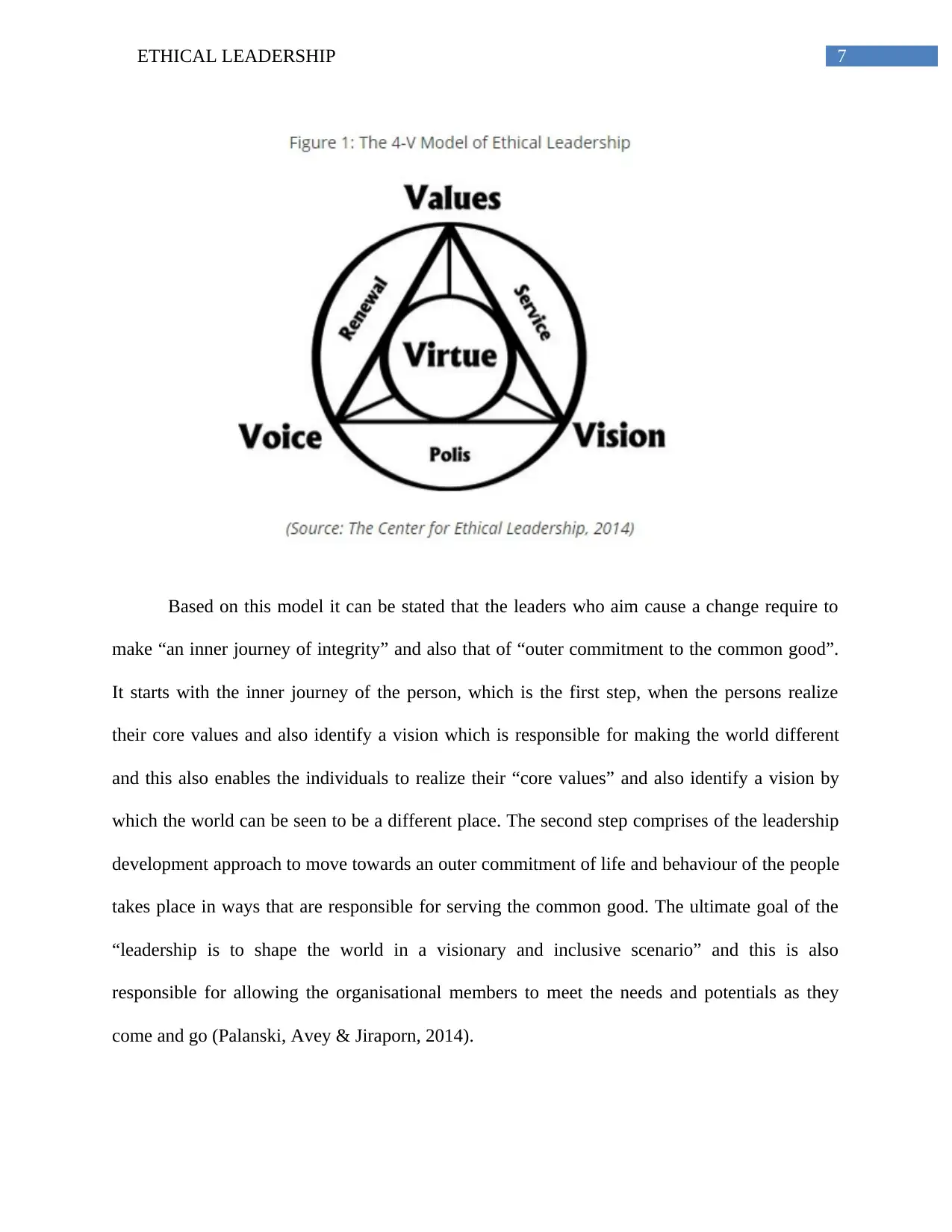
7ETHICAL LEADERSHIP
Based on this model it can be stated that the leaders who aim cause a change require to
make “an inner journey of integrity” and also that of “outer commitment to the common good”.
It starts with the inner journey of the person, which is the first step, when the persons realize
their core values and also identify a vision which is responsible for making the world different
and this also enables the individuals to realize their “core values” and also identify a vision by
which the world can be seen to be a different place. The second step comprises of the leadership
development approach to move towards an outer commitment of life and behaviour of the people
takes place in ways that are responsible for serving the common good. The ultimate goal of the
“leadership is to shape the world in a visionary and inclusive scenario” and this is also
responsible for allowing the organisational members to meet the needs and potentials as they
come and go (Palanski, Avey & Jiraporn, 2014).
Based on this model it can be stated that the leaders who aim cause a change require to
make “an inner journey of integrity” and also that of “outer commitment to the common good”.
It starts with the inner journey of the person, which is the first step, when the persons realize
their core values and also identify a vision which is responsible for making the world different
and this also enables the individuals to realize their “core values” and also identify a vision by
which the world can be seen to be a different place. The second step comprises of the leadership
development approach to move towards an outer commitment of life and behaviour of the people
takes place in ways that are responsible for serving the common good. The ultimate goal of the
“leadership is to shape the world in a visionary and inclusive scenario” and this is also
responsible for allowing the organisational members to meet the needs and potentials as they
come and go (Palanski, Avey & Jiraporn, 2014).

8ETHICAL LEADERSHIP
It is also to be mentioned that the “4-V model of leadership” includes the 4 different
“sides of ethical leadership including that of values, vision, voice and virtue”. Values are the
crucial factor within the model. In order to develop the “ethical leadership” the leader needs to
begin with a proper knowledge as to the core values of the individual (Schaubroeck et al., 2012).
Secondly the vision is the ability of the leader to “incorporate his or her actions within the
framework of an existent system”. Being the third side voice needs to be claimed for articulation
of the vision to the others in order to be motivated into action. Fourthly, virtue which is the
common good is to be fostered by the leaders with the practice of virtuous behaviour so that
people can strive to do the correct things (Avey, Wernsing & Palanski, 2012).
The key additional elements of the 4-V model are that of “service, polis and renewal”.
Service is responsible for connecting vision to the values which are tested by means of service
and the vision is often revealed. Polis or politics indicate that an organisation is engaged in the
art of politics at the time voice is given to the purpose of vision in the public context. “Renewal
is defined to be the territory where voice returns to values and voice can be expressed in various
ways”. It is desirable that the leaders consider if the actions are consistent with morals and aim
(Shin, 2012).
Impact of “ethical leadership on employee turnover”:
Employee turnover is a crucial challenge in the organisations. The employees are
considered to be crucial assets of the organisation and the organisational costs which are incurred
due to the reasons of job quitting, “subsequent hiring of replacement personnel, new-hire training
and administration” are considerable. There has been an increased interest in the development
and the promotion of ethical leadership (Eisenbeiss, 2012). “Ethical leadership is considered to
It is also to be mentioned that the “4-V model of leadership” includes the 4 different
“sides of ethical leadership including that of values, vision, voice and virtue”. Values are the
crucial factor within the model. In order to develop the “ethical leadership” the leader needs to
begin with a proper knowledge as to the core values of the individual (Schaubroeck et al., 2012).
Secondly the vision is the ability of the leader to “incorporate his or her actions within the
framework of an existent system”. Being the third side voice needs to be claimed for articulation
of the vision to the others in order to be motivated into action. Fourthly, virtue which is the
common good is to be fostered by the leaders with the practice of virtuous behaviour so that
people can strive to do the correct things (Avey, Wernsing & Palanski, 2012).
The key additional elements of the 4-V model are that of “service, polis and renewal”.
Service is responsible for connecting vision to the values which are tested by means of service
and the vision is often revealed. Polis or politics indicate that an organisation is engaged in the
art of politics at the time voice is given to the purpose of vision in the public context. “Renewal
is defined to be the territory where voice returns to values and voice can be expressed in various
ways”. It is desirable that the leaders consider if the actions are consistent with morals and aim
(Shin, 2012).
Impact of “ethical leadership on employee turnover”:
Employee turnover is a crucial challenge in the organisations. The employees are
considered to be crucial assets of the organisation and the organisational costs which are incurred
due to the reasons of job quitting, “subsequent hiring of replacement personnel, new-hire training
and administration” are considerable. There has been an increased interest in the development
and the promotion of ethical leadership (Eisenbeiss, 2012). “Ethical leadership is considered to
⊘ This is a preview!⊘
Do you want full access?
Subscribe today to unlock all pages.

Trusted by 1+ million students worldwide
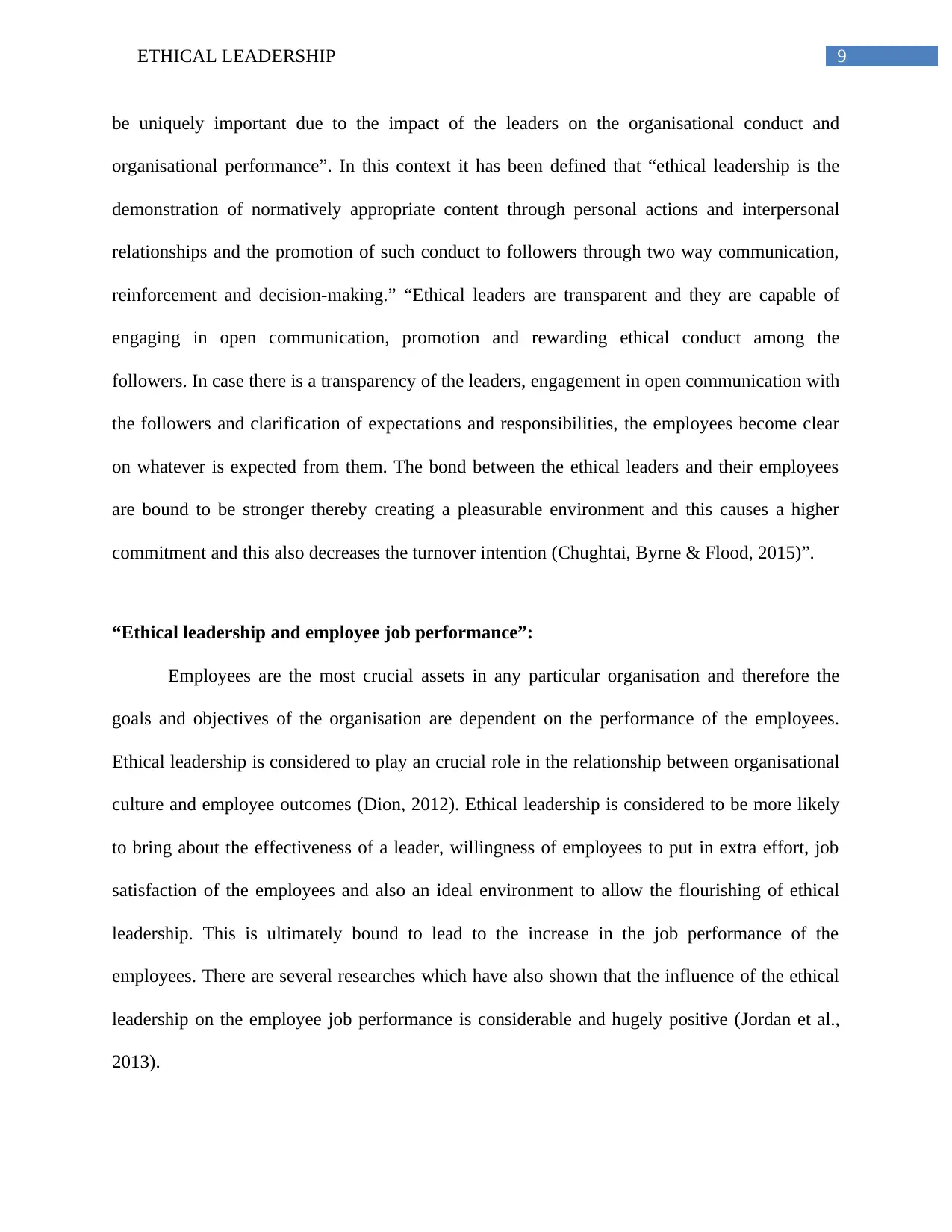
9ETHICAL LEADERSHIP
be uniquely important due to the impact of the leaders on the organisational conduct and
organisational performance”. In this context it has been defined that “ethical leadership is the
demonstration of normatively appropriate content through personal actions and interpersonal
relationships and the promotion of such conduct to followers through two way communication,
reinforcement and decision-making.” “Ethical leaders are transparent and they are capable of
engaging in open communication, promotion and rewarding ethical conduct among the
followers. In case there is a transparency of the leaders, engagement in open communication with
the followers and clarification of expectations and responsibilities, the employees become clear
on whatever is expected from them. The bond between the ethical leaders and their employees
are bound to be stronger thereby creating a pleasurable environment and this causes a higher
commitment and this also decreases the turnover intention (Chughtai, Byrne & Flood, 2015)”.
“Ethical leadership and employee job performance”:
Employees are the most crucial assets in any particular organisation and therefore the
goals and objectives of the organisation are dependent on the performance of the employees.
Ethical leadership is considered to play an crucial role in the relationship between organisational
culture and employee outcomes (Dion, 2012). Ethical leadership is considered to be more likely
to bring about the effectiveness of a leader, willingness of employees to put in extra effort, job
satisfaction of the employees and also an ideal environment to allow the flourishing of ethical
leadership. This is ultimately bound to lead to the increase in the job performance of the
employees. There are several researches which have also shown that the influence of the ethical
leadership on the employee job performance is considerable and hugely positive (Jordan et al.,
2013).
be uniquely important due to the impact of the leaders on the organisational conduct and
organisational performance”. In this context it has been defined that “ethical leadership is the
demonstration of normatively appropriate content through personal actions and interpersonal
relationships and the promotion of such conduct to followers through two way communication,
reinforcement and decision-making.” “Ethical leaders are transparent and they are capable of
engaging in open communication, promotion and rewarding ethical conduct among the
followers. In case there is a transparency of the leaders, engagement in open communication with
the followers and clarification of expectations and responsibilities, the employees become clear
on whatever is expected from them. The bond between the ethical leaders and their employees
are bound to be stronger thereby creating a pleasurable environment and this causes a higher
commitment and this also decreases the turnover intention (Chughtai, Byrne & Flood, 2015)”.
“Ethical leadership and employee job performance”:
Employees are the most crucial assets in any particular organisation and therefore the
goals and objectives of the organisation are dependent on the performance of the employees.
Ethical leadership is considered to play an crucial role in the relationship between organisational
culture and employee outcomes (Dion, 2012). Ethical leadership is considered to be more likely
to bring about the effectiveness of a leader, willingness of employees to put in extra effort, job
satisfaction of the employees and also an ideal environment to allow the flourishing of ethical
leadership. This is ultimately bound to lead to the increase in the job performance of the
employees. There are several researches which have also shown that the influence of the ethical
leadership on the employee job performance is considerable and hugely positive (Jordan et al.,
2013).
Paraphrase This Document
Need a fresh take? Get an instant paraphrase of this document with our AI Paraphraser

10ETHICAL LEADERSHIP
Organisational examples:
Microsoft is an organisation which “illustrates the 4-V Model of ethical leadership. The
use of leadership helps Bill Gates in notably releasing the key tensions within the leadership” at
the time of the globalisation process of Microsoft. The passion intensity, integrity and ore values
have been developed by the leader of Microsoft. Philanthropy plays a huge role in the
organisation (Kalshoven, Den Hartog & De Hoogh, 2013). Organisations like Starbucks,
Goldman Sachs, Patagonia, Intel also abide by the values of ethical leadership. These
organisations believe in serving the common good. The leaders are also capable enough of
aligning his actions regarding the correct things to do. In the globalization process, majority of
the competitors of the companies do not give major importance to the concept of humanity. The
focus on ethical leadership is responsible for increasing the overall brand image of the
patronizing companies. In conclusion it can be said that ethical leadership is an effective tool by
which the leaders become capable enough of managing their organisations (Resick et al., 2013).
Conclusion:
Leadership is responsible for playing an important role in organisational success. Having
the presence of ethical leadership within a particular organisation is responsible for playing an
important role in organisational performance and for having successful performance, the
organisations need a follower who is capable of properly guiding his or her followers. Possessing
an ethical and effective leadership can help the organisations sustain in their impact of
worldwide business. It has been suitably found and stated that ethical leadership is facilitated by
a transformational style of leadership. The personal characteristic traits also go a long way in the
determination of ethical behaviour and this fosters the ethical culture in the organisations. The
choice of correct and proper leaders for a particular task is not easy and therefore the leaders who
Organisational examples:
Microsoft is an organisation which “illustrates the 4-V Model of ethical leadership. The
use of leadership helps Bill Gates in notably releasing the key tensions within the leadership” at
the time of the globalisation process of Microsoft. The passion intensity, integrity and ore values
have been developed by the leader of Microsoft. Philanthropy plays a huge role in the
organisation (Kalshoven, Den Hartog & De Hoogh, 2013). Organisations like Starbucks,
Goldman Sachs, Patagonia, Intel also abide by the values of ethical leadership. These
organisations believe in serving the common good. The leaders are also capable enough of
aligning his actions regarding the correct things to do. In the globalization process, majority of
the competitors of the companies do not give major importance to the concept of humanity. The
focus on ethical leadership is responsible for increasing the overall brand image of the
patronizing companies. In conclusion it can be said that ethical leadership is an effective tool by
which the leaders become capable enough of managing their organisations (Resick et al., 2013).
Conclusion:
Leadership is responsible for playing an important role in organisational success. Having
the presence of ethical leadership within a particular organisation is responsible for playing an
important role in organisational performance and for having successful performance, the
organisations need a follower who is capable of properly guiding his or her followers. Possessing
an ethical and effective leadership can help the organisations sustain in their impact of
worldwide business. It has been suitably found and stated that ethical leadership is facilitated by
a transformational style of leadership. The personal characteristic traits also go a long way in the
determination of ethical behaviour and this fosters the ethical culture in the organisations. The
choice of correct and proper leaders for a particular task is not easy and therefore the leaders who
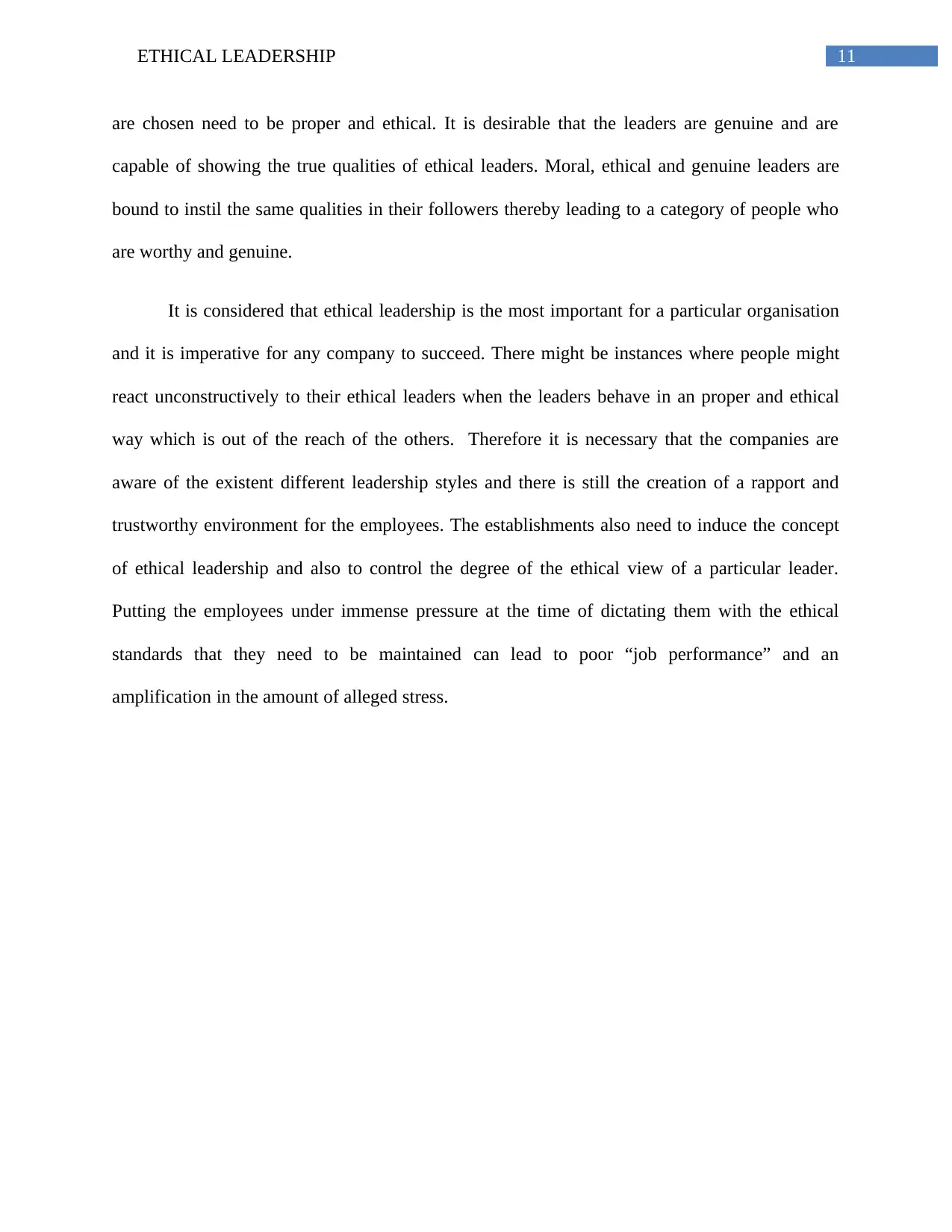
11ETHICAL LEADERSHIP
are chosen need to be proper and ethical. It is desirable that the leaders are genuine and are
capable of showing the true qualities of ethical leaders. Moral, ethical and genuine leaders are
bound to instil the same qualities in their followers thereby leading to a category of people who
are worthy and genuine.
It is considered that ethical leadership is the most important for a particular organisation
and it is imperative for any company to succeed. There might be instances where people might
react unconstructively to their ethical leaders when the leaders behave in an proper and ethical
way which is out of the reach of the others. Therefore it is necessary that the companies are
aware of the existent different leadership styles and there is still the creation of a rapport and
trustworthy environment for the employees. The establishments also need to induce the concept
of ethical leadership and also to control the degree of the ethical view of a particular leader.
Putting the employees under immense pressure at the time of dictating them with the ethical
standards that they need to be maintained can lead to poor “job performance” and an
amplification in the amount of alleged stress.
are chosen need to be proper and ethical. It is desirable that the leaders are genuine and are
capable of showing the true qualities of ethical leaders. Moral, ethical and genuine leaders are
bound to instil the same qualities in their followers thereby leading to a category of people who
are worthy and genuine.
It is considered that ethical leadership is the most important for a particular organisation
and it is imperative for any company to succeed. There might be instances where people might
react unconstructively to their ethical leaders when the leaders behave in an proper and ethical
way which is out of the reach of the others. Therefore it is necessary that the companies are
aware of the existent different leadership styles and there is still the creation of a rapport and
trustworthy environment for the employees. The establishments also need to induce the concept
of ethical leadership and also to control the degree of the ethical view of a particular leader.
Putting the employees under immense pressure at the time of dictating them with the ethical
standards that they need to be maintained can lead to poor “job performance” and an
amplification in the amount of alleged stress.
⊘ This is a preview!⊘
Do you want full access?
Subscribe today to unlock all pages.

Trusted by 1+ million students worldwide
1 out of 15
Related Documents
Your All-in-One AI-Powered Toolkit for Academic Success.
+13062052269
info@desklib.com
Available 24*7 on WhatsApp / Email
![[object Object]](/_next/static/media/star-bottom.7253800d.svg)
Unlock your academic potential
Copyright © 2020–2025 A2Z Services. All Rights Reserved. Developed and managed by ZUCOL.





